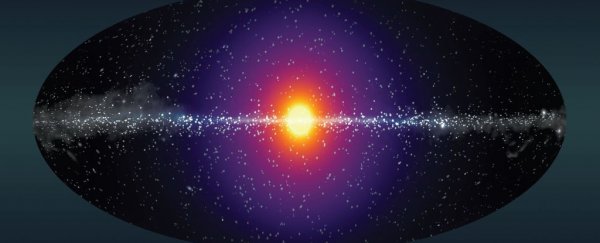Once again, a search for signs of dark matter outside its gravitational effect has turned up zilch - but this time it's a little more controversial. Astronomers peering into empty space have not found an X-ray glow hypothesised to be the product of one particular dark matter candidate: the sterile neutrino.
It is, the researchers say, a result that throws a bit of a dampener on this candidate as a leading contender for dark matter - but doesn't extinguish it entirely.
Dark matter is a huge old question mark. Although we can't detect it directly, we know it's out there because it's having a really big gravitational effect on the stuff we can detect, also known as normal matter.
For instance, stuff on the outer edges of galaxies moves faster than it should if it were under the gravitational influence of normal matter alone. And gravitational lensing - the way gravity bends the path of light - is stronger than we would expect, too. From these effects, astronomers have calculated that as much as 85 percent of the matter in the Universe is dark matter.
Because we can't detect it, though, we don't know what it is. And there are a number of hypothetical candidates, with astronomers trying to come up with ways to detect these.
The sterile neutrino is a hypothetical particle. Normal neutrinos, the most abundant particles in the Universe, are very hard to detect at the best of times - they are similar to electrons, but with no charge and very little mass, so they barely interact with normal matter. A sterile neutrino, physicists have hypothesised, wouldn't interact with normal matter at all, except maybe gravitationally.
But these hypothetical neutrinos are unstable, too. They should decay into normal neutrinos and electromagnetic radiation. And, if they are so decaying, then that radiation should be detectable. Very faint, but detectable.
That's what a 2014 study claimed to have done - detected the faint X-rays from sterile neutrino decay from distant galaxies, an emission called the 3.5 KeV line. But then follow-up studies - one in 2016 on a dwarf galaxy 260,000 light-years away, and another in 2017 on a galaxy cluster 240 million light-years away - found no such thing.
So, a team of researchers decided to look a bit closer to home. We know the Milky Way has a substantial dark matter halo, so if sterile neutrinos are decaying in it, they should be detectable around the galaxy.
The team conducted a meta-analysis of 20 years of raw archival X-ray data of empty space around the Milky Way, where other glowing objects wouldn't create interference, taken by the XMM-Newton space telescope, looking for signs of that 3.5 KeV emission. They didn't find any.
"This 2014 paper and follow-up works confirmed the signal generated a significant amount of interest in the astrophysics and particle physics communities because of the possibility of knowing, for the first time, precisely what dark matter is at a microscopic level," said physicist Ben Safdi of the University of Michigan.
"Our finding does not mean that the dark matter is not a sterile neutrino, but it means that - contrary to what was claimed in 2014 - there is no experimental evidence to-date that points towards its existence."
The result suggests that something else was causing the 3.5 KeV glow seen in that 2014 study, the researchers said. But not everyone is convinced. Physicist Alexey Boyarsky of Leiden University in the Netherlands posted a similar survey to preprint server arXiv, looking at the blank sky of the Milky Way. His team believes they did find the 3.5 KeV line.
"I think this paper is wrong," he said of the new research to Science Magazine. The different results could be the product of the two different analysis techniques; both teams believe their method is superior, although Boyarsky's paper is yet to be peer-reviewed.
So it seems the question may still be somewhat open, and only more research can help to resolve it.
Meanwhile, there's another direction that can be taken, too. Safdi says that his team's conclusions open up a new avenue for further search on the matter.
"While this work does, unfortunately, throw cold water on what looked like what might have been the first evidence for the microscopic nature of dark matter, it does open up a whole new approach to looking for dark matter which could lead to a discovery in the near future," he said.
The research has been published in Science.
